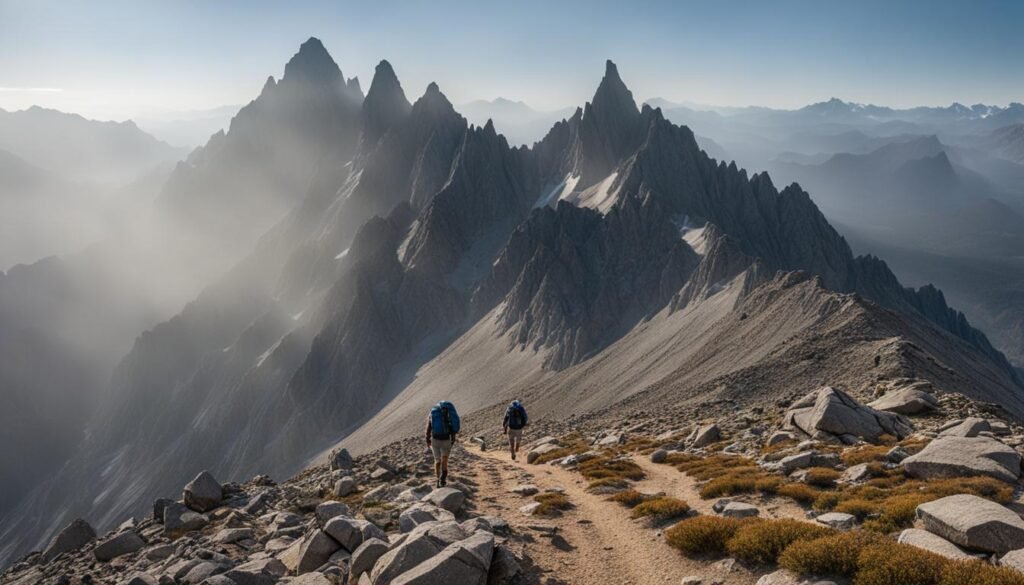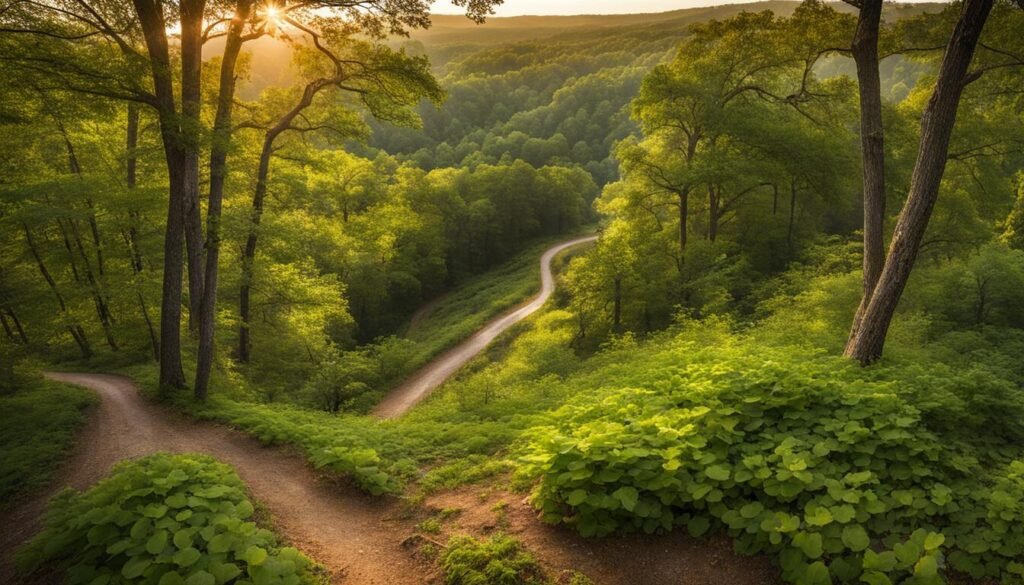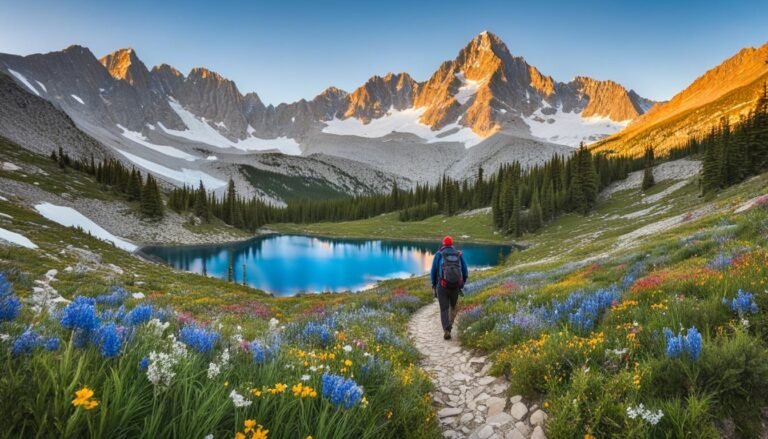For those with a passion for the great outdoors and a love for extended treks, the long-distance hiking trails in America offer some of the best natural experiences in the world. Whether you’re looking to check off your bucket list hiking trails or simply immerse yourself in the serene beauty only accessible on foot, you’ll find solace and breathtaking landscapes along the nation’s top long-distance trails.
From the vast stretches of wilderness in the popular hiking trails of the Pacific Crest to the Appalachian Trail’s lush greenery, American long-distance trails beckon adventurers of all kinds. These trails paint a picture of the country’s diverse geography, offering a mosaic of experiences from coastal forests to alpine peaks. As we explore some of the best hiking trails in America, prepare to encounter the raw beauty and challenge that these scenic hiking trails present.
The Pacific Crest Trail: A Trek Through California, Oregon, and Washington
Embark on a journey along the Pacific Crest Trail (PCT), one of the most illustrious long-distance hiking trails in America. This monumental path weaves through diverse landscapes across California, Oregon, and Washington, presenting outdoor enthusiasts with the ultimate test of endurance and a chance to experience unparalleled natural splendor.
Wild Beauty and Diverse Ecosystems
On the PCT hike, travelers tread through a continuous transition from arid deserts to frosty mountain peaks. This California hiking trail first bounds through the Mojave Desert, soon giving way to the majestic forests and volcanic views in Oregon trails, and finally, culminating amidst the exhilarating Washington outdoor adventures. The Pacific Crest Trail is a parade of ecosystems, bearing witness to North America’s rich biodiversity.
Trail by Foot, Horseback, or Bicycle
Whether on foot, horseback, or alongside the dedicated bicycle route, the PCT welcomes adventurers of all kinds. This trail marks an intersection of people from all walks of life, bound by a shared passion for amongst the great California, Oregon, and Washington outdoors. Enjoy the camaraderie of like-minded hikers, the carefully synchronized steps of equestrians, or the soft whirr of cyclists – all finding a common rhythm with nature.
Challenges Faced by Thru-Hikers
Thru-hikers on the PCT face daunting challenges that test their physical prowess, mental perseverance, and survival skills. From extreme weather to difficult terrain, less than 200 brave souls annually earn the title of a PCT thru-hiker, having covered the extensive stretch from the Mexican to Canadian borders. Meticulous preparation and unwavering resolve are the cornerstones of charting this storied path.
| Challenge | Details | Preparation Tips |
|---|---|---|
| Weather Extremes | From the scorching heat of the Mojave Desert to the unpredictable snow in the Sierra Nevada. | Carry adaptable gear and clothing, anticipate water sources, and closely monitor weather reports. |
| Rugged Terrain | Encounter various terrains including rocky paths, high-altitude passes, and dense forests. | Ensure adequate physical training and carry reliable navigation tools. |
| Wildlife Encounters | Potential interactions with bears, snakes, and other wildlife species native to these transit regions. | Understand animal behavior, store food safely, and know the measures to take in an encounter. |
| Isolation | Long stretches between resupply points and potential for solitude-induced mental fatigue. | Plan resupply points, carry a communication device, and engage with trail community for support. |
John Muir Trail: California’s High Sierra Wilderness
Immersing oneself in the California wilderness begins with stepping onto one of the best hiking trails in America—the John Muir Trail. This storied path cuts a 210-mile long swath through the heart of the High Sierras, offering more than just a hike—it’s a pilgrimage through the epitome of natural beauty. From the iconic granite cliffs of hiking in Yosemite to the formidable ascent of the Mount Whitney climb, the trail serves as a testament to the wild spirit of the West and the legacy of its namesake, environmentalist John Muir.

- Spanning from the verdant meadows of Yosemite Valley to the summit of Mount Whitney, hikers tread through a changing tapestry of alpine forests, serene lakes, and rocky passes.
- As trekkers climb above 7,000 feet, they find themselves enveloped in the serenity of the high-altitude wilderness, necessitating self-sufficiency and respect for the rugged environs.
- Acclimatization is key as one prepares for the trail’s climax at 14,505 feet, making the Mount Whitney climb a rewarding, though demanding, culmination.
The John Muir Trail not only challenges the body but also nourishes the soul with isolated stretches where one can commune with nature undisturbed. Each step taken on this journey is a step back into the era when the California wilderness was wild and untamed, offering a modern-day adventure steeped in the wisdom and vision of John Muir himself. Heralded as one of the best hiking trails in America, the John Muir Trail stands unrivaled in both its heritage and the profound experiences it bestows upon those who traverse its path.
American Icons: Hiking the Continental Divide Trail
Embarking on the monumental journey of the Continental Divide Trail (CDT) is a pilgrimage through the heartland of America’s rugged wilderness. For intrepid hikers, it’s not merely a path but a voyage that unfolds the splendor of the Rockies, weaving through diverse states and offering an epic narrative of endurance and natural beauty.
Traversing Five States Along the Rocky Mountains
Tracing the topographical spine of North America, hikers challenge their resolve along the CDT’s 3,100-mile ribbon across New Mexico, Colorado, Wyoming, Idaho, and Montana. This network of trails reveals the pristine grandeur of the Rockies, from the sweeping deserts of the south to the snow-capped peaks of the north, making it one of the most legendary long-distance trails in New Mexico and its sister states. Thrill-seekers and nature lovers alike flock to test their mettle, whether it’s through the high-altitude Colorado hiking trails or the remote expanses of Montana trekking territory.
Hiking Logistics and Route Finding Challenges
Conquering the Continental Divide isn’t just about physical stamina; it’s mastering the art of navigation and preparedness as you traverse incomplete trails and unpredictable weathers. With around 30% of the trail yet to be designated, hikers must become adept at reading topographic maps and orienteering across remote regions. The sparse supply points amplify the challenge of this adventure, demanding methodical planning and resilience against the unpredictable mountain elements.
Close Encounters with American Wildlife
In the depths of the wilderness, the CDT presents an opportunity to experience wildlife in its most untamed state. Adventurers will find themselves guests in a land ruled by the majestic wildlife of the west, from the roaming herds of Wyoming to the elusive creatures of Idaho’s thick forests. Each step enshrines a unification with nature, making every Wyoming wildlife sighting or silent watch of an Idaho adventure a treasured highlight.
Here’s a snapshot of what to expect when trekking the diverse sections of the CDT:
| State | Notable Features | Wildlife Encounters | Trail Completion |
|---|---|---|---|
| New Mexico | Desert landscape, Chihuahuan Desert | Reptiles, Roadrunners, Coyotes | Segmented |
| Colorado | Rocky Mountain National Park, San Juan’s high alpine routes | Elk, Moose, Black Bears | Mostly complete |
| Wyoming | Yellowstone Park, Wind River Range | Grizzlies, Wolves, Bison | Partially bridged by road walks |
| Idaho & Montana | Continental Divide Basin, Bob Marshall Wilderness | Mountain Goats, Grizzly Bears | Wilderness routes |
Ultimately, the Continental Divide Trail beckons as a test of spirit and skill, a true jewel among the storied hiking the Rocky Mountains tradition. It is a transformative experience that continues to draw those who seek the ultimate communion with America’s unwritten wilderness.
Appalachian Trail: Connecting 14 States from Georgia to Maine
Touted as the “granddaddy” of long-distance hiking trails in America, the Appalachian Trail offers an epic thru-hike captivating the spirits of adventurers across the globe. Stretching for over 2,185 miles, it serves as an arterial passageway from Georgia hiking environs through the heart of the Eastern US, culminating in the rugged Maine outdoor adventure landscape.
With more than 250 shelters scattered across its length, the Appalachian Trail is unique in its offer of communal lodgings, enabling many to undertake this journey without the need for a personal tent. This attribute not only reduces the load on a hiker’s back but also nurtures a sense of community among those trekking the path together—often fostering lifelong friendships among those who share the trail.
With its comprehensive waymarking and proximity to civilization, it stands as one of the best long-distance hiking trails, attracting those who seek to traverse multiple states in a single hike and soak in the diverse American landscapes. Below, find a snapshot of the trail’s features:
| Feature | Description |
|---|---|
| States Crossed | 14 – From Georgia to Maine |
| Total Distance | 2,185 miles |
| Shelters | Over 250 along the trail |
| Remarkable Segment | The Hundred-Mile Wilderness in Maine |
| Accessibility | Numerous towns and roads along the route |
The Appalachian Trail embraces hikers of all capabilities, from those testing the waters of long-distance hiking to seasoned mountaineers. It captures the essence of the American spirit and the yearning for exploration, earning its reputation as a significant chapter in the anthology of hiking across states.
The Historical Long Trail of Vermont
Stepping onto Vermont’s Long Trail, one enters a realm of natural splendor, where the Green Mountains unfold and the trail’s storied past beckons hikers into the wild. Managed by the Green Mountain Club, this path is a testament to the profound beauty of wilderness trails on the East Coast and stands proud among the best hiking trails in America. It stretches across Vermont, offering endless possibilities to experience both nature’s serenity and the thrill of an extended adventure.
The Nation’s First Long-Distance Trail
The ground underfoot on The Long Trail carries the weight of history, being the first long-distance trail established in the United States. Visionary members of the Green Mountain Club, aiming to build a trail ‘from the Massachusetts border to Canada’, accomplished this feat, inspiring the birth of an interconnected network of East Coast trails. The Long Trail is a cornerstone of American hiking culture, providing a scenic traverse through Vermont’s majestic high peaks and verdant forests.
Experiencing East Coast Wilderness Solitude
On the Long Trail, solitude is not merely a concept; it is the hiker’s companion. As one of the wilderness trails less frequented than its southern counterpart, the Appalachian Trail, Vermont hiking offers a more secluded experience, an immersion into an environment where one’s thoughts and nature’s whispers are the only conversation. Here, along the path forged by the Green Mountain Club, is where one truly finds the essence of what many consider the best hiking trails in America.
| Trek Highlights | Trail Tips | Shelter Info |
|---|---|---|
| Gentle pathways to rugged mountain ascents | Prepare for varying weather conditions | Over 70 shelters available along the route |
| Access to all of Vermont’s 4,000-foot peaks | Carry a reliable map and trail guides | Shelters are first-come-first-serve |
| Unparalleled views of the New England wilderness | Leave No Trace principles are a must | Most shelters provide basic amenities |
Hayduke Trail: A Desert Adventure in Arizona and Utah
Embark on an epic journey through the heart of the American Southwest on the Hayduke Trail, one of the best long-distance hiking trails known for its unforgiving yet mesmerizing desert adventures. Stretching for 812 rugged miles, it’s a path less trodden that weaves through the dramatic arid landscapes of Arizona trails and offers unforgettable Utah hiking experiences.
This demanding route begins its serpentine course in the striking formations of Arches National Park and continues to awe adventurers as it snakes through the magnificence of Canyonlands, before reaching the towering cliffs of Zion National Park. With the trail named after a beloved Edward Abbey character, it’s easy to feel intertwined with the raw literary spirit and visceral wildness that defines the Hayduke Trail.
Prepare to navigate through some of the most remote segments of the arid, red rock expanses that define the unique beauty of the American Southwest. The solitude of this trail, complemented by the stark vastness of the desert, offers an unparalleled adventure for those who dare to tread its path.
Only a select few have completed the enticing challenge of the full Hayduke Trail, a true testament to the trail’s rigorous demands and awe-inspiring rewards.
Here’s a snapshot of what adventurers can expect when considering the Hayduke Trail:
- Stunning national parks, each with its own unique topography and challenges
- Scarce water sources that require thorough planning and conservation strategies
- Technical navigation skills needed for successful route-finding through remote areas
For weekend backpackers and day hikers, the Hayduke Trail presents a myriad of opportunities to explore segments of this spectacular region, solidifying its rank as a top destination for those in search of the ultimate desert hiking experience.
| National Park | Highlight | Terrain Type |
|---|---|---|
| Arches National Park | Iconic Delicate Arch | Dramatic sandstone formations |
| Canyonlands National Park | Majestic Island in the Sky | Canyons and mesas |
| Zion National Park | The Narrows | Steep sandstone cliffs |
While the complete journey might be reserved for those with the expertise and spirit akin to George Hayduke himself, the Hayduke Trail calls to every soul yearning to uncover the secrets of the Southwest, step by rugged step. Just remember, in these lands where the spirits of adventure and wilderness collide, preparation and respect for the environment are your crucial companions.

The Grandeur of the Grand Enchantment Trail
As one of the best hiking trails in America, the Grand Enchantment Trail is a marvel of wilderness hiking that extends from the urban edges of Phoenix to the vibrant culture of Albuquerque. Celebrated among the most exciting long-distance trails in the Southwest, it encapsulates both the raw beauty and the challenging environment of the stark, yet breathtaking landscapes.
Linking Phoenix and Albuquerque Through Wild Country
The Grand Enchantment Trail offers a unique blend of accessibility and remoteness. Starting in the bustling city of Phoenix, this trail quickly whisks hikers away into serene backcountry, dotted with hidden oases and wide-open skies. The rocky spires and sun-soaked valleys make it a standout among Phoenix hiking trails, while hikers on the Albuquerque end are treated to outdoor excursions unrivaled in their scenic diversity and historical richness.
Water Sources and Historical Significance
Resting within the arid expanses of the trail, water sources become not just a commodity but lifelines. The route, optimally traversed during the spring season, reveals nature’s ingeniously timed water supply through snowmelt. Hikers can explore the historical tapestry woven into the trail, including the ancient Gila Cliff Dwellings, where the echoes of Pueblo ancestors lend an awe-inspiring perspective on this incredible Albuquerque outdoor excursion.
For the intrepid soul seeking connection with America’s rugged Southwest, the Grand Enchantment Trail is a journey offering deep communion with the natural world and a glimpse into our historic past, making it one of the wilderness hiking experiences of a lifetime.
Ozark Highlands Trail: America’s Midwest Beauty
The Ozark Highlands Trail is a celebrated Arkansas hiking trail that meanders through the majestic Ozark Mountains, unfolding over 218 miles of classic Midwest wilderness. As a beacon of year-round hiking, this scenic trail in America captivates with its diverse panoramas and welcoming terrain.
Hikers from every corner flock to uncover the splendors of the Ozarks, enjoying the easing blend of state park facilities and natural expanses. The refreshing waters of the White River accompany the trail, unveiling an untouched 15-mile stretch that encapsulates the soul of the Midwest’s serene outdoors.

Experience seekers will find solace in the trail’s perpetual accessibility. While other trails succumb to winter’s embrace, the Ozark Highlands Trail stands robust, promising a lush and vibrant passage regardless of the season. Here’s a closer look at the amenities you can expect along this scenic adventure:
| Feature | Description | Trail Sections |
|---|---|---|
| Accessibility | Year-round hiking opportunities | Entire length of the trail |
| Natural Attractions | Rivers, waterfalls, and limestone bluffs | Multiple points along the trail |
| Amenities | Campgrounds, showers, and recreational areas | Scattered across state parks and trailheads |
| Recreational Activities | Hiking, camping, fishing, and wildlife viewing | Various locations along the trail |
Whether you are a nature photographer eager to capture the essence of America’s scenic trails or an outdoor enthusiast searching for a dynamic hiking experience, the Ozark Highlands Trail stands as a quintessential slice of natural Americana, proudly placing Arkansas hiking trails on the map.
Retracing the Last Ice Age on Wisconsin’s Ice Age Trail
The Ice Age Trail is not merely a path but a journey back in time, a chance to walk alongside the ghosts of glaciers past. In Wisconsin, this captivating Wisconsin hiking trail unfolds across the state, forging through diverse glacial landscapes that were sculpted by an epoch long gone. As one of the best long-distance trails in America, it beckons hikers and history buffs alike to explore geological trails where remnants of the Ice Age still linger.
Post-Glacial Landscapes and Geological Wonders
Along the sprawling length of the Ice Age Trail, explorers can marvel at the geographical storybook that is Wisconsin’s terrain. With every step, trekking enthusiasts encounter a testimony to Earth’s former climatic fury, where geological trails wind through an ecological treasure trove, spotlighting not just Wisconsin’s beauty but also the resilience of nature.
| Trail Segment | Notable Features | Length |
|---|---|---|
| Western Bifurcation | Rolling prairies and savannas | 75 miles |
| Central Moraines | Kettle ponds and drumlins | 200 miles |
| Eastern Lobe | Cliff-top vistas over the Great Lakes | 150 miles |
| Southern Kettle Moraine | Thick forests and spring-fed lakes | 110 miles |
The Ice Age Trail stands as a resilient ribbon of land, unifying a collection of American scenic trails with the shared narrative of Wisconsin’s enthralling geological inheritance. For those who embrace this route, it promises a profound connection with nature, a truly unique among best long-distance trails in America.
Long-Distance Hiking Trails in America: The Ultimate Guide to Endurance and Beauty
For those who yearn for an outdoor adventure hiking experience, tackling an American long-distance trail is the ultimate test of endurance. These trails, carved through some of the nation’s most breathtaking landscapes, invite hikers into a world where scenic beauty converges with the raw challenge of endurance hikes. This comprehensive trail guide America has been your companion through the most iconic treks, where each step unlocks a piece of the grand mosaic that is American wilderness.

Let’s delve deeper into what makes these trails a haven for trekkers and nature lovers alike. With a table that highlights the key features, prepare to be inspired to embark on your next hiking odyssey.
| Trail Name | Distance | State(s) | Notable Features |
|---|---|---|---|
| Pacific Crest Trail | 2,653 mi | CA, OR, WA | Ecosystem diversity, requiring thorough preparation |
| Appalachian Trail | 2,200 mi | GA to ME | Accessibility, numerous shelters, community feel |
| Continental Divide Trail | 3,100 mi | NM, CO, WY, ID, MT | Extreme conditions, wildlife encounters |
| John Muir Trail | 210 mi | CA | High Sierras, stunning elevations |
| Long Trail | 272 mi | VT | Historical significance, Green Mountain peaks |
In the grand scheme of American long-distance trails, each path not only tests the hiker’s grit but also tells a story of the land it passes through. From the high-altitude quests to the dense, forested walks, these trails demand respect and offer profound rewards. So whether you’re seeking solitude, desiring to test your limits, or wanting to absorb the scenic beauty America generously provides, gather your gear and let the call of these trails guide your next outdoor adventure hiking journey.
Conclusion
America’s vast landscapes serve as the backdrop for unforgettable long-distance hiking adventures, each trail woven into the very fabric of the nation’s wild heart. The paths and passages laid out before you are more than mere waypoints; they are opportunities for remarkable transformative journeys. Through every step, from the preparation to the sweet moment of trail completion, hikers are etching their narratives into the annals of the great outdoors.
The spirit of America’s hiking community is encapsulated within each trail’s unique experience. Whether ascending the majestic peaks along the Appalachian Trail, enduring the harsh but beautiful terrains of the Hayduke, or retracing history on the Ice Age Trail, you’re undertaking a venture steeped in discovery and kinship with those who have trekked before you. Each route offers not just a challenge, but also invites you into a breadth of stories and shared sense of achievement with other passionate wanderers.
The call of the American wilderness experience is loud and beckoning, promising rich rewards for those who yield to its summons. These storied paths offer a wellspring of solitude, exhilaration, and communion with nature, calling forth the adventurous spirit that dwells within each of us. As we contemplate the vast tapestry of the United States and its myriad of serpentine trails, remember that to embark is to transform; for every journey reshapes the soul, and every trail leaves an indelible mark upon the heart of the traveler.


